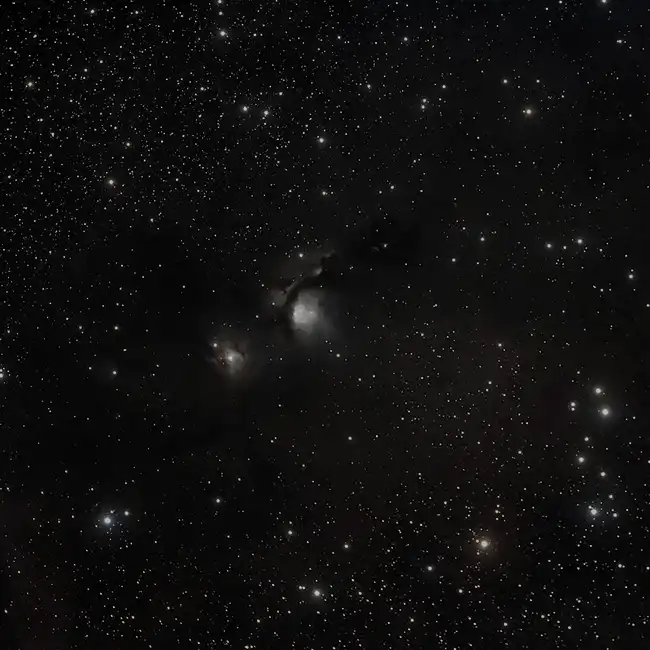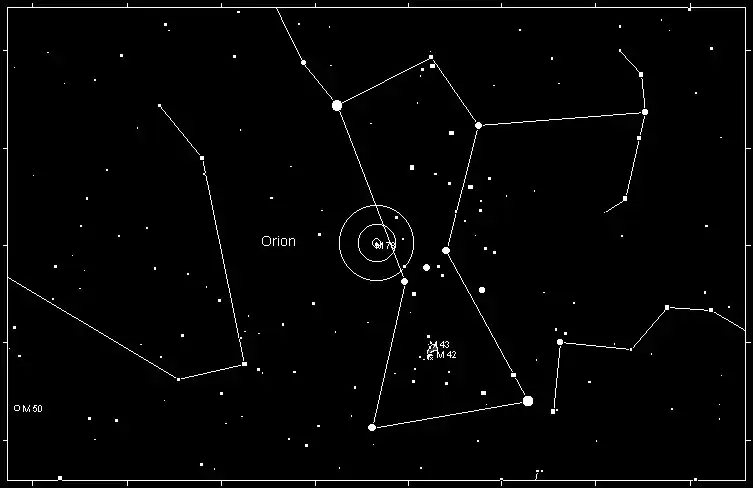Messier 78 (M78), a fascinating reflection nebula, is one of the brightest nebulae in the night sky. Located in the constellation Orion, M78 offers amateur astronomers a striking view of cosmic dust illuminated by the glow of nearby stars. This article explores the characteristics of M78, its magnitude, visibility, and how to find it, along with its rich history in the catalog of cosmic wonders.
Messier 78 is a reflection nebula, meaning it doesn't emit its light but rather reflects the light of nearby stars. The nebula spans about 5 light-years across and is located approximately 1,600 light-years from Earth. What makes M78 particularly captivating is the bluish glow caused by the scattering of light from its central stars, HD 38563A and HD 38563B. The nebula also contains a dark lane, a region of dense dust that obscures the light, adding to its mystique.
M78 is part of a larger molecular cloud complex in Orion, which includes other famous nebulae like the Orion Nebula (M42) and the Horsehead Nebula. This region is a stellar nursery, where new stars are continuously forming within the clouds of gas and dust.
Magnitude
Messier 78 has an apparent magnitude of 8.0, making it one of the brighter reflection nebulae visible from Earth. While it is not visible to the naked eye, it can be easily observed through small telescopes under dark skies. The nebula's brightness makes it an accessible target for amateur astronomers.

Season and Constellation
M78 is best observed during the winter months, particularly from December to February, when the constellation Orion is prominently visible in the night sky. Located in Orion, one of the most recognizable constellations, M78 lies near the "belt" of Orion, making it relatively easy to locate.
How to Find Messier 78
To locate Messier 78, first, find the constellation Orion. The three bright stars that form Orion's Belt—Alnitak, Alnilam, and Mintaka—serve as excellent reference points. M78 is situated about 2.5 degrees to the northeast of Alnitak, the easternmost star of Orion's Belt.
Using a low-power eyepiece, begin by centering Alnitak in your telescope's field of view. Slowly pan northeast, and you should encounter a faint, diffuse glow, which is M78. Increasing the magnification can help resolve the details, such as the dark lane and the bluish reflection, especially under good observing conditions.

History
Messier 78 was discovered by French astronomer Pierre Méchain on December 19, 1780, and was subsequently included in Charles Messier's famous catalog of deep-sky objects. Messier, whose primary interest was in cataloging objects that could be mistaken for comets, added M78 as the 78th entry in his list.
Over the centuries, M78 has been studied extensively, revealing its role as a stellar nursery. The nebula is part of the Orion Molecular Cloud Complex, a region rich in star formation, and has provided astronomers with valuable insights into the processes that govern the birth of stars.
In the 19th century, British astronomer William Herschel conducted detailed observations of M78, furthering our understanding of its structure and the stars within it. Later, advancements in photography and spectroscopy allowed astronomers to study M78 in greater detail, revealing the presence of young stars still embedded in their natal clouds of gas and dust.
Conclusion
Messier 78 is a stunning example of a reflection nebula, offering a window into the star-forming processes occurring within our galaxy. Its relatively bright magnitude and location in the easily recognizable constellation of Orion make it an attractive target for amateur astronomers. Observing M78 with a telescope reveals not only its beauty but also a glimpse into the cosmic dynamics that shape our universe. Whether you're an experienced stargazer or a novice, M78 is a celestial gem worth exploring.
